
The family Fulgoridae is a large group of hemipteran insects, especially abundant and diverse in the tropics, containing over 125 genera worldwide. They are mostly of moderate to large size, many with a superficial resemblance to Lepidoptera due to their brilliant and varied coloration. Various genera and species are sometimes referred to as lanternflies or lanthorn flies, but neither do their heads emit light, nor are they even distantly related to flies.

Eurybrachidae is a small family of planthoppers with species occurring in parts of Asia, Australia and Africa. They are remarkable for the sophistication of their automimicry.

The fulgorid genus Fulgora contains several large Central and South American planthoppers known by a large variety of common names including lantern fly, peanut bug, peanut-headed lanternfly, alligator bug, machaca, and jequitiranaboia.

Pyrops is a genus of planthoppers that occur primarily in southeast Asia, containing about 70 species. They are fairly large insects, with much of the length due to an elongated, upcurving, snout-like projection of the head. The wings are generally brightly patterned in contrasting colors, and they are popular among collectors.
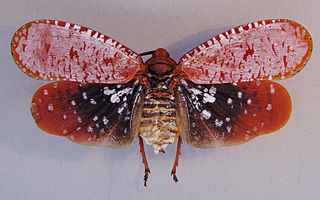
The subfamily Aphaeninae is a group of hemipteran insects, especially abundant and diverse in the tropics, in the family Fulgoridae, or "lanternflies".

Issidae is a family of planthoppers described by Spinola in 1839, belonging to the order Hemiptera, suborder Auchenorrhyncha superfamily Fulgoroidea.

Pyrops watanabei is a species of planthopper endemic to Taiwan. Pyrops atroalbus was formerly considered a subspecies; its status as a species was reinstated in 2017. P. watanabei was first described by Shōnen Matsumura in 1913 as Fulgora watanabei.
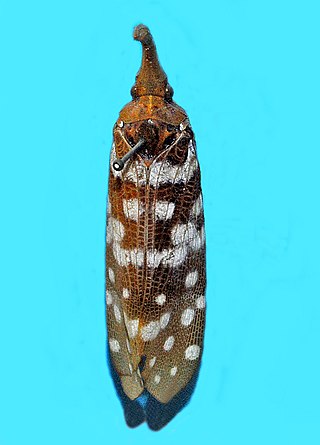
Pyrops maculatus is a species of planthopper belonging to the family Fulgoridae. A population is found in Sri Lanka while another is known from southwestern India.

Lycorma is a genus of planthoppers native to Asia. The first species within the genus was described by Frederick William Hope in 1843 and the genus was formally established by Carl Stål in 1863.

The Fulgorinae are a sub-family of insects in the Auchenorrhyncha: which include the spectacular "lantern-bugs" and allied insects.
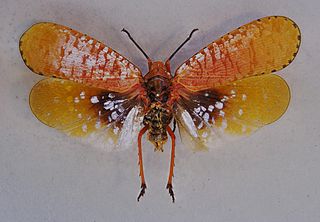
Aphaena is a genus of planthoppers in the sub-family Aphaeninae of Fulgoridae. Species are distributed from eastern India, Indo-China, China and Malesia.

Polydictya is a genus of planthoppers in the sub-family Poiocerinae Haupt, 1929. Species are distributed from India, through Indo-China, to Malesia.

The subfamily Poiocerinae include Hemipteran insects in the family Fulgoridae, found especially in the tropics.
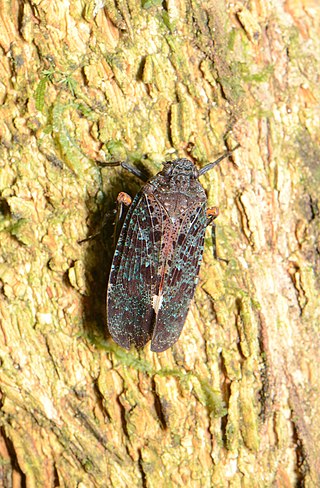
Penthicodes variegatus is a species of planthoppers in the subfamily Aphaeninae (Fulgoridae): found in South-East Asia. It belongs to the subgenus EreosomaKirkaldy, 1906. The genus name was formerly treated as feminine, but in 2022 it was revised to masculine in accordance with ICZN Article 30.1.4.4, changing the spelling of this species' name from variegata to variegatus.
Penthicodes pulchellus is a species of planthoppers in the subfamily Aphaeninae (Fulgoridae): found in southern India, Indo-China and Malesia. It belongs to the subgenus EreosomaKirkaldy, 1906. The genus name was formerly treated as feminine, but in 2022 it was revised to masculine in accordance with ICZN Article 30.1.4.4, changing the spelling of this species' name from pulchella to pulchellus.
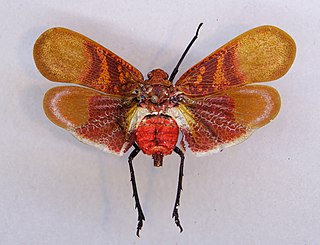
Scamandra is a genus of planthoppers in the subfamily Aphaeninae (Fulgoridae): found in Malesia.
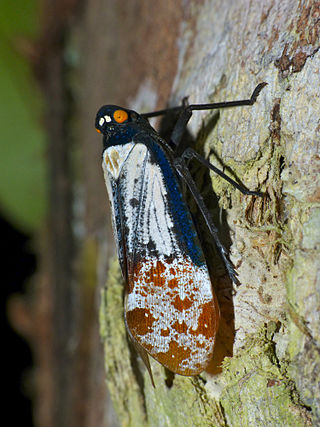
Penthicodes farinosus is a species of planthoppers in the subfamily Aphaeninae (Fulgoridae): with five subspecies distributed in Indo-China and Malesia. The genus name was formerly treated as feminine, but in 2022 it was revised to masculine in accordance with ICZN Article 30.1.4.4, changing the spelling of this species' name from farinosa to farinosus.

Eurybrachys is a genus of bugs in the family Eurybrachidae. First formally named in 1834 by French entomologist Félix Édouard Guérin-Méneville, Eurybrachys is the type genus of the family Eurybrachidae. The spelling Eurybrachis, by the author, is considered an unaccepted orthographic variant. Species in this genus occur in Asia.
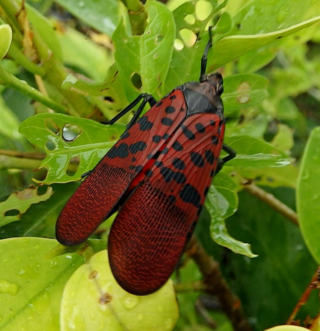
Lycorma meliae is a planthopper species endemic to Taiwan, with multiple, dramatically different color morphs depending on the life stage. The species was described by Masayo Kato in Taiwan in 1929, and is the only member of its genus confirmed to be native to the island. In 1929, a specimen of L. meliae was originally described as a separate species, L. olivacea, also by Kato. These two taxon names were declared synonymous in 2023. L. meliae undergoes four instar stages before achieving adulthood and generally only survive until the winter.
Egregia is a genus of planthoppers in the family Fulgoridae, subfamily Aphaeninae. Species are distributed in Malesia. As of 2020, the number of species increased to 24.

















